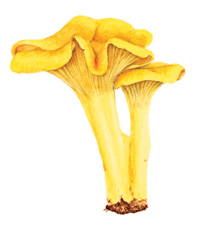Awanadjo Almanack - Issue 121
Blue Hill: the Town, the Bay, the Mountain
By Rob McCall
I have a total irreverence for anything connected with society except that which makes the roads safer, the beer stronger, the food cheaper, and the old men and old women warmer in the winter and happier in the summer.
The trees add another ring to their girth All summer long, while the grasses of the field grow long and lush, while the wildflowers bloom and fade and set their seeds, while the fruits of the garden ripen, the big trees are adding another ring to their girth and another span to their height. A healthy woodlot may look pretty much the same from one year to the next, but it is almost invisibly adding half a cord or more of wood per acre every year. The bigger the tree, the more wood it adds. This is the fundamental miracle and source of life on earth. Left alone, the green cell combines sunlight, water, and nourishment derived from the soil to make more and more life. Animals, in turn, derive their life from plants. A big tree is the actual breathing incarnation of this miracle. This goes a long way toward explaining why the Tree of Life is mentioned in both the first and last books of the Bible and why big trees are honored, even worshiped around the world. Shinto priests bring offerings to big trees in the mountains of Japan, and tree-huggers live in the tops of giant redwoods in California to protect them from being felled. In my saunters around town I have found a number of exceedingly large specimens: a yellow “Getchell” birch halfway up the mountain surrounded by a grove of its offspring, a sugar maple on Pleasant Street in the village, a white pine at Parker Ridge, and a huge white ash near Closson’s in North Blue Hill, to name a few. It is hard to pass one of these giants without admiring it, speaking to it, yes, even hugging it and feeling the pulse of its surging sap pressing against your heart. These heroes have successfully weathered the storms of far more than a human lifetime, and they humble us with their great size and age, their constancy, their productivity, and their peaceful patience. They deserve to be honored as icons and monuments to the majesty of life on earth. Illustrations by Candice Hutchison (3)
Seedpod to carry around with you
From Adlai Stevenson: “A hypocrite is the kind of politician who would cut down a redwood tree, then mount the stump and make a speech for conservation.”
And from Ronald Reagan: “A tree is a tree. How many more do you need to look at?”
Rank opinion
You hear a lot of talk about “buying local” and “eating local” these days, and that is good. But what is “local?” Does it mean something grown in your own town? Or state? Or region? Is an ice cream made in Vermont local if there is perfectly good ice cream made closer to home? Is “organic” lettuce trucked here from California as healthy as lettuce grown in our own town?
It grieves me to see earnest young farmers with bare-foot kids and sun-browned faces behind rows and rows of beautiful local vegetables waiting for a customer to come by, or worse yet, packing up lots of unsold produce when the market closes. We have many farmers’ markets in our area. Not only is their produce the freshest and healthiest, but these hard-working folks are our best insurance against food insecurity should the big trucks from who-knows-where ever stop rolling out here far off the Interstate. The best thing we can do is patronize our farmers’ markets and be vocal about eating local.
Saltwater report, mid August
Nothing could be more local and organic than downeast clams and mussels, plentiful and affordable this time of year.
Field and forest report, late August
Walking through the late summer fields we remember from seasons past the evocative names of the wildflowers now blooming. It’s surprising to discover how many of them are cousins in one big family, the asters, or as the botanists would say, the Asteraceae. Black-eyed Susan, several varieties of yellow and orange hawkweed, tansy, pineapple-weed, Jerusalem artichoke, fleabane, burdock, chicory, pearly everlasting, many of the different goldenrods, all the familiar asters of white, pink, and purple, the common dandelion, sunflower, daisy, echinacea, and even the reviled ragweed are all members of this large and remarkable family. They all share a circular central “eye” of many small florets arranged in a spiral surrounded by petals in multiples of five. Check out The Plants of Acadia National Park by Mittlehauser, Gregory, Rooney & Weber (University of Maine Press, 2010). It’s a pleasure to read. Now I can’t look anywhere without seeing an aster in bud or bloom or going to seed. It’s a new level of seeing: discovering unseen connections that were there all along.
Illustrations by Candice Hutchison (3)
Seedpod to carry around with you
From Adlai Stevenson: “A hypocrite is the kind of politician who would cut down a redwood tree, then mount the stump and make a speech for conservation.”
And from Ronald Reagan: “A tree is a tree. How many more do you need to look at?”
Rank opinion
You hear a lot of talk about “buying local” and “eating local” these days, and that is good. But what is “local?” Does it mean something grown in your own town? Or state? Or region? Is an ice cream made in Vermont local if there is perfectly good ice cream made closer to home? Is “organic” lettuce trucked here from California as healthy as lettuce grown in our own town?
It grieves me to see earnest young farmers with bare-foot kids and sun-browned faces behind rows and rows of beautiful local vegetables waiting for a customer to come by, or worse yet, packing up lots of unsold produce when the market closes. We have many farmers’ markets in our area. Not only is their produce the freshest and healthiest, but these hard-working folks are our best insurance against food insecurity should the big trucks from who-knows-where ever stop rolling out here far off the Interstate. The best thing we can do is patronize our farmers’ markets and be vocal about eating local.
Saltwater report, mid August
Nothing could be more local and organic than downeast clams and mussels, plentiful and affordable this time of year.
Field and forest report, late August
Walking through the late summer fields we remember from seasons past the evocative names of the wildflowers now blooming. It’s surprising to discover how many of them are cousins in one big family, the asters, or as the botanists would say, the Asteraceae. Black-eyed Susan, several varieties of yellow and orange hawkweed, tansy, pineapple-weed, Jerusalem artichoke, fleabane, burdock, chicory, pearly everlasting, many of the different goldenrods, all the familiar asters of white, pink, and purple, the common dandelion, sunflower, daisy, echinacea, and even the reviled ragweed are all members of this large and remarkable family. They all share a circular central “eye” of many small florets arranged in a spiral surrounded by petals in multiples of five. Check out The Plants of Acadia National Park by Mittlehauser, Gregory, Rooney & Weber (University of Maine Press, 2010). It’s a pleasure to read. Now I can’t look anywhere without seeing an aster in bud or bloom or going to seed. It’s a new level of seeing: discovering unseen connections that were there all along.
 Field and forest report, late September
Fall mushrooms are showing their exotic caps and stalks in fields and woods. Some of these are poisonous and some are not, and they often look alike, so take an expert with you if you go mushroom hunting. We had several giant puffballs (Calvatia gigantean) growing in our front yard that we watched with interest as they grew larger every day. Sadly, someone stole them all, and our dreams of slices fried in butter or of Hungarian mushroom soup were stolen with them. This is not foraging; this is theft. But if you would like some apples, our orchard is well supplied. Just call or knock on the door, and you will be welcome.
Natural events, late September
Last year at this time we were stacking firewood in the woodshed, one of the most humble and pleasant tasks you could want. I like to fit in carefully each piece of stove wood like a puzzle, high as I can reach, with a nice cribwork at the end of each row. Each piece is as sweet as a candy bar when you smell it, with flavors of birch beer and maple syrup. Each piece is as precious as gold when you think of the hours of heat waiting there to keep us warm as kings. Each piece is organic, local, and renewable, and warms the conscience as well as the toes.
Natural events, early October
Ever so slowly turns the wheel of the seasons. Dawn may come up like thunder on the road to Mandalay, and March may come in like a lion in Maine, but summer turns to fall silently as a tumbling leaf and slowly as the new moon grows to full. First the heat eases and the sun starts to sleep later and retire earlier. Towering summer clouds melt, soften, and spread into overcast. Aging leaves turn leathery and opaque and rusty around the edges. Mushrooms of diverse shapes and colors spring up like magic; caterpillars that look like something by Dr. Seuss parade along the fence rails and the woodpile. Purple and white asters stand and sway in the fields, while in the woods seed cones sticky with rosin drop from spruce and fir to waiting jays and squirrels. Bumblebees and butterflies hasten on their rounds to drink the last nectars of the year before the flowery fountains cease to flow. The aromas of afternoon go from perfume to spice. The frosts come like strokes, slowing the darting insects and daubing the leaves with umber and vermilion until, like Byron and Shelley, their very brilliance brings them down. Grasses and wildflowers turn brown and rattle in the north wind, and all that was warm and wet turns dry and cold as rocky hills, bouldered fields, and stony shores prepare for winter’s sleep.
Field and forest report, late September
Fall mushrooms are showing their exotic caps and stalks in fields and woods. Some of these are poisonous and some are not, and they often look alike, so take an expert with you if you go mushroom hunting. We had several giant puffballs (Calvatia gigantean) growing in our front yard that we watched with interest as they grew larger every day. Sadly, someone stole them all, and our dreams of slices fried in butter or of Hungarian mushroom soup were stolen with them. This is not foraging; this is theft. But if you would like some apples, our orchard is well supplied. Just call or knock on the door, and you will be welcome.
Natural events, late September
Last year at this time we were stacking firewood in the woodshed, one of the most humble and pleasant tasks you could want. I like to fit in carefully each piece of stove wood like a puzzle, high as I can reach, with a nice cribwork at the end of each row. Each piece is as sweet as a candy bar when you smell it, with flavors of birch beer and maple syrup. Each piece is as precious as gold when you think of the hours of heat waiting there to keep us warm as kings. Each piece is organic, local, and renewable, and warms the conscience as well as the toes.
Natural events, early October
Ever so slowly turns the wheel of the seasons. Dawn may come up like thunder on the road to Mandalay, and March may come in like a lion in Maine, but summer turns to fall silently as a tumbling leaf and slowly as the new moon grows to full. First the heat eases and the sun starts to sleep later and retire earlier. Towering summer clouds melt, soften, and spread into overcast. Aging leaves turn leathery and opaque and rusty around the edges. Mushrooms of diverse shapes and colors spring up like magic; caterpillars that look like something by Dr. Seuss parade along the fence rails and the woodpile. Purple and white asters stand and sway in the fields, while in the woods seed cones sticky with rosin drop from spruce and fir to waiting jays and squirrels. Bumblebees and butterflies hasten on their rounds to drink the last nectars of the year before the flowery fountains cease to flow. The aromas of afternoon go from perfume to spice. The frosts come like strokes, slowing the darting insects and daubing the leaves with umber and vermilion until, like Byron and Shelley, their very brilliance brings them down. Grasses and wildflowers turn brown and rattle in the north wind, and all that was warm and wet turns dry and cold as rocky hills, bouldered fields, and stony shores prepare for winter’s sleep.
 The comforts of the calendar and the turning of the seasons come back home to us in autumn. It is always soothing to pick up the latest almanac and look at the old woodcuts, charts, and archaic symbols whose forms change so little over the decades, and even centuries, yet whose details change considerably from one year to the next. They show change within changelessness. Time can be seen either as like a circle repeating endlessly, or like a straight line always moving into the future. But time can also be seen as both a circle and
The almanac is the calm recalling of the fundamental events taking place in the heavens and on the earth—day and night, summer and winter, cold and heat, seedtime and harvest—which have peacefully, ceaselessly repeated through the eons while monuments to the great are built and crumble, wars rage and come to an end, markets boom and bust, and empires rise and fall. The almanac is a companion in your flight beyond all that dies and toward all that lives forever. No wonder it rested next to the Bible on sea voyages and pilgrimages, in covered wagons, and on the homely book shelves of our ancestors.
Saltwater report, mid October
Duck season is under way with silent hunters and their patient dogs awaiting the quack of dawn in wetlands, ponds and bays.
Field and forest report, mid October
We walk under showers of flaming maple leaves that kiss the earth then crumble underfoot with the aroma of spices and wild tobacco. These are elderly leaves, scarred and frayed by the wear and tear endured in their short lifetime. They are pocked by anthracnose and tar-spot. They are dingy with sooty mold; they are perforated by insects and tattered by storms; they are bent and broken. Yet they gloriously float and fall, aflame with color. Like our elders, they are lighted with fire from within. The leaves fall, the trees remain. We die, the human race abides. Little lives come to an end, the Big Life goes on.
Just so, at this time of year the yearlings of wild animals must leave their homes and find new territory of their own. Many meet an early death on the roads and lie mostly un-mourned by us. Porcupines, raccoons, squirrels, skunks rest as though sleeping while we go speeding by. If you have time, show some respect for our little cousins by stopping and moving their bodies off the road onto the welcoming soil, which will quickly bring them back into the bigger life. Keep a pair of gloves and a shovel in your vehicle. If you can’t do that, at least offer them a blessing as you pass. Such kindness will not go unrewarded: you will become an honorary member of the Wandering Order of St. Francis the Undertaker, a pilgrim who shows compassion for forgotten animals killed by our carelessness.
Natural events, late October
The bare bones of trees are now seen against the sky as the foliage falls, and the leaf-peepers set their eyes and their GPSs toward the south. With no hard frost yet flowers still bloom in the garden, the mill brook rushes with autumn rains, chipmunks stay longer in their burrows, and crows perch dripping on fence posts. On sunny days the light is a bone white, bleached of all color, what John Gardner called “October light.” On cloudy days the sky is a soft, muffled gray from horizon to horizon, and wood smoke spices the air. The day grows shorter and night longer as we rise and lie down in the dark. The hint of death is in the air as we make our way towards Hallowe’en, Samhain, and All Soul’s Day.
Field and forest report, late October
Firearms season for deer hunting is also right around the corner. Blaze orange gear appears at the general store and on dashboards everywhere, a sign of solidarity among sportsmen. Unfortunately, many others associate this color with fear—fear of walking in the woods, fear for the suffering of other animals. Worst of all, a few sportsmen and hunters flaunt it by driving around town with bleeding carcasses in the back of the truck or hanging them in the front yard for all to see. The annual hue and cry about hunting rises in the letters pages of the newspaper, and great is the tumult thereof.
Rank opinion I
The truth of the matter is that most hunters are dedicated, knowledgeable, compassionate, ethical, and deeply decent. They see the deer hunt as an ancient and honorable way to bring good, healthy, organic meat home to be shared with those who need and love it. There is many a poor family that has been cheered by a haunch of deer or moose or a brace of waterfowl appearing on the doorstep. It is local and sustainable, contributes to the health of the ecosystem, and is far more compassionate than the factory farms from which most of us get our meat. Respect is due all around: for the hunter, for the non-hunter, but most of all for the elegant, the beautiful, the graceful white-tailed deer, spirit of the evergreen forest.
Rank opinion II
More and more we have shifted our attention from local news to global news. Local and regional newspapers are falling away like leaves in October while more and more of us get our news from the Internet. I have a hunch that most of us know more about what is happening in New York or Washington or Beijing than we do about our own town or Augusta. Without the Ellsworth district court reports in the papers and the delinquent taxpayers list in the town report we’d have nothing left to talk about but the foibles of national celebrities. Here’s a quiz: Name your selectmen, state representative, road commissioner, school superintendent, and your neighbors on all sides.
Tick-tock-tick-tock.... Time!
Give yourself a grade. Then give yourself a homework assignment.
More seedpods to carry around with you
From Charles Kuralt: “To read the papers and to listen to the news... one would think the country is in terrible trouble. You do not get that impression when you travel the back roads; and the small towns do care about their country and wish it well.”
And from E.F. Schumacher: “Small is beautiful.”
That’s the almanack for this time. But don’t take it from us—we’re no experts. Go out and see for yourself.
The comforts of the calendar and the turning of the seasons come back home to us in autumn. It is always soothing to pick up the latest almanac and look at the old woodcuts, charts, and archaic symbols whose forms change so little over the decades, and even centuries, yet whose details change considerably from one year to the next. They show change within changelessness. Time can be seen either as like a circle repeating endlessly, or like a straight line always moving into the future. But time can also be seen as both a circle and
The almanac is the calm recalling of the fundamental events taking place in the heavens and on the earth—day and night, summer and winter, cold and heat, seedtime and harvest—which have peacefully, ceaselessly repeated through the eons while monuments to the great are built and crumble, wars rage and come to an end, markets boom and bust, and empires rise and fall. The almanac is a companion in your flight beyond all that dies and toward all that lives forever. No wonder it rested next to the Bible on sea voyages and pilgrimages, in covered wagons, and on the homely book shelves of our ancestors.
Saltwater report, mid October
Duck season is under way with silent hunters and their patient dogs awaiting the quack of dawn in wetlands, ponds and bays.
Field and forest report, mid October
We walk under showers of flaming maple leaves that kiss the earth then crumble underfoot with the aroma of spices and wild tobacco. These are elderly leaves, scarred and frayed by the wear and tear endured in their short lifetime. They are pocked by anthracnose and tar-spot. They are dingy with sooty mold; they are perforated by insects and tattered by storms; they are bent and broken. Yet they gloriously float and fall, aflame with color. Like our elders, they are lighted with fire from within. The leaves fall, the trees remain. We die, the human race abides. Little lives come to an end, the Big Life goes on.
Just so, at this time of year the yearlings of wild animals must leave their homes and find new territory of their own. Many meet an early death on the roads and lie mostly un-mourned by us. Porcupines, raccoons, squirrels, skunks rest as though sleeping while we go speeding by. If you have time, show some respect for our little cousins by stopping and moving their bodies off the road onto the welcoming soil, which will quickly bring them back into the bigger life. Keep a pair of gloves and a shovel in your vehicle. If you can’t do that, at least offer them a blessing as you pass. Such kindness will not go unrewarded: you will become an honorary member of the Wandering Order of St. Francis the Undertaker, a pilgrim who shows compassion for forgotten animals killed by our carelessness.
Natural events, late October
The bare bones of trees are now seen against the sky as the foliage falls, and the leaf-peepers set their eyes and their GPSs toward the south. With no hard frost yet flowers still bloom in the garden, the mill brook rushes with autumn rains, chipmunks stay longer in their burrows, and crows perch dripping on fence posts. On sunny days the light is a bone white, bleached of all color, what John Gardner called “October light.” On cloudy days the sky is a soft, muffled gray from horizon to horizon, and wood smoke spices the air. The day grows shorter and night longer as we rise and lie down in the dark. The hint of death is in the air as we make our way towards Hallowe’en, Samhain, and All Soul’s Day.
Field and forest report, late October
Firearms season for deer hunting is also right around the corner. Blaze orange gear appears at the general store and on dashboards everywhere, a sign of solidarity among sportsmen. Unfortunately, many others associate this color with fear—fear of walking in the woods, fear for the suffering of other animals. Worst of all, a few sportsmen and hunters flaunt it by driving around town with bleeding carcasses in the back of the truck or hanging them in the front yard for all to see. The annual hue and cry about hunting rises in the letters pages of the newspaper, and great is the tumult thereof.
Rank opinion I
The truth of the matter is that most hunters are dedicated, knowledgeable, compassionate, ethical, and deeply decent. They see the deer hunt as an ancient and honorable way to bring good, healthy, organic meat home to be shared with those who need and love it. There is many a poor family that has been cheered by a haunch of deer or moose or a brace of waterfowl appearing on the doorstep. It is local and sustainable, contributes to the health of the ecosystem, and is far more compassionate than the factory farms from which most of us get our meat. Respect is due all around: for the hunter, for the non-hunter, but most of all for the elegant, the beautiful, the graceful white-tailed deer, spirit of the evergreen forest.
Rank opinion II
More and more we have shifted our attention from local news to global news. Local and regional newspapers are falling away like leaves in October while more and more of us get our news from the Internet. I have a hunch that most of us know more about what is happening in New York or Washington or Beijing than we do about our own town or Augusta. Without the Ellsworth district court reports in the papers and the delinquent taxpayers list in the town report we’d have nothing left to talk about but the foibles of national celebrities. Here’s a quiz: Name your selectmen, state representative, road commissioner, school superintendent, and your neighbors on all sides.
Tick-tock-tick-tock.... Time!
Give yourself a grade. Then give yourself a homework assignment.
More seedpods to carry around with you
From Charles Kuralt: “To read the papers and to listen to the news... one would think the country is in terrible trouble. You do not get that impression when you travel the back roads; and the small towns do care about their country and wish it well.”
And from E.F. Schumacher: “Small is beautiful.”
That’s the almanack for this time. But don’t take it from us—we’re no experts. Go out and see for yourself.

Rob McCall is a journalist, naturalist, and fiddler, and pastor of the First Congregational Church of Blue Hill, Maine UCC. This column derives from his weekly radio show on WERU, 89.9 FM, Blue Hill and 99.9 Bangor. Readers can contact him directly via e-mail: awanadjoalmanack@gmail.com or post a comment using the form below.
—Brendan Behan, Irish poet
The trees add another ring to their girth All summer long, while the grasses of the field grow long and lush, while the wildflowers bloom and fade and set their seeds, while the fruits of the garden ripen, the big trees are adding another ring to their girth and another span to their height. A healthy woodlot may look pretty much the same from one year to the next, but it is almost invisibly adding half a cord or more of wood per acre every year. The bigger the tree, the more wood it adds. This is the fundamental miracle and source of life on earth. Left alone, the green cell combines sunlight, water, and nourishment derived from the soil to make more and more life. Animals, in turn, derive their life from plants. A big tree is the actual breathing incarnation of this miracle. This goes a long way toward explaining why the Tree of Life is mentioned in both the first and last books of the Bible and why big trees are honored, even worshiped around the world. Shinto priests bring offerings to big trees in the mountains of Japan, and tree-huggers live in the tops of giant redwoods in California to protect them from being felled. In my saunters around town I have found a number of exceedingly large specimens: a yellow “Getchell” birch halfway up the mountain surrounded by a grove of its offspring, a sugar maple on Pleasant Street in the village, a white pine at Parker Ridge, and a huge white ash near Closson’s in North Blue Hill, to name a few. It is hard to pass one of these giants without admiring it, speaking to it, yes, even hugging it and feeling the pulse of its surging sap pressing against your heart. These heroes have successfully weathered the storms of far more than a human lifetime, and they humble us with their great size and age, their constancy, their productivity, and their peaceful patience. They deserve to be honored as icons and monuments to the majesty of life on earth.
 Illustrations by Candice Hutchison (3)
Illustrations by Candice Hutchison (3)

Yr. mst. hmble & obd’nt servant,
Rob McCall

Rob McCall is a journalist, naturalist, and fiddler, and pastor of the First Congregational Church of Blue Hill, Maine UCC. This column derives from his weekly radio show on WERU, 89.9 FM, Blue Hill and 99.9 Bangor. Readers can contact him directly via e-mail: awanadjoalmanack@gmail.com or post a comment using the form below.
Related Articles
Share this article:
2023 Maine Boat & Home Show

Join Us for the Maine Boat & Home Show!
Art, Artisans, Food, Fun & Boats, Boats, Boats
August 11 - 13, 2023 | On the waterfront, Rockland, Maine
Click here to pre-order your tickets.
Show is produced by Maine Boats, Homes & Harbors magazine.















